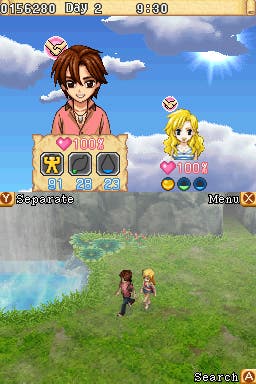Lost in Blue 3
You taste like fishbiscuits.
I'm in danger of repeating myself here. First, there was Lost in Blue, which cast you as a male shipwreck survivor on a desert island with a lone female survivor for company. You divided your time between foraging for food to fill the demanding stomachs of your little castaways, babysitting your useless companion so that she didn't die of thirst when you were out fetching carrots, and exploring the island, looking for new materials, tools and, eventually, a means of escape.
Then, there was Lost in Blue 2, which was exactly the same, except for the added choice to play as the girl or the boy, a different story and the fact that your companion was considerably less useless. Both shared the same unique virtues, and the same significant problems: the series' great disadvantage is that it does absolutely nothing to make itself accessible, to ease new players in or to reveal the secret tricks that alleviate the constant grind of day-to-day survival.
And now, here is Lost and Blue 3 - still desperately inaccessible, unforgiving and slow-paced, still hugely unhelpful to the novice player, and still uniquely compelling, gratifying and emotive once you get under its skin. There are differences, and significant ones at that, but at its heart it's still the same awkward but loveable game.
Lost in Blue is all about balancing day-to-day survival with exploration. At first, your characters can never venture too far from their cave, bound by the constraints of their appetites and ever-depleting energy, which a night's sleep on a cold stone floor does little to replenish. Gradually, though, as you inch further and further out into the wilderness and discover better materials with which to make better tools and become more efficient at hunting, fishing and gathering, life gets a bit easier, and before too long you can head out on proper expeditions and come back to a venison dinner and beds made out of animal fur. It's a little bit like Harvest Moon, in that it involves hard work, repetition and gradual improvement, but the reward lies in seeing more and more of the island, discovering exotic food, wild animals and delicious mysteries.

The big new thing about Lost in Blue 3 is that instead of coping by yourselves, you and your partner are joined by other survivors as the game goes on - and with them comes the option to replay the game as any of them to see the story from another angle. As you uncover more of the island, the characters' separate background stories grow clearer, and the bigger mysteries of the island and the sunken ship slowly emerge. Every Lost in Blue game has had multiple endings, but the story has never diverged to anything like this extent - it's a much greater part of the game this time around, as is island exploration. Working in a group of four has its advantages, as every character contributes to the welfare of the group by hunting animals or helping out with furniture, materials and tools - as long as you remember to ask them.
The downside of this new dynamic is that each character has specific abilities, which actually limits what the player character can do. Where the Jack and Amy of Lost in Blue 2 were equally capable, Lost in Blue 3's girl characters can't use a bow or rod, and the boys can't cook with anything more than the basic utensils. This makes playing as one of the girl characters really inconvenient, as you have to rely on the boys to do any half-decent hunting or fishing and do most of the cooking yourself - something that's difficult to get used to after tending to the every need of your partner in the previous two games, and which makes defending the game against allegations of sexism a little more difficult.


